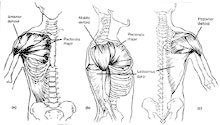Unfortunately, deltoids are a muscle group that can be quite stubborn. I genetically blessed few have wide shoulders with naturally round deltoids, but for the majority of us, we have to bust our asses to get bigger shoulders. The goal of this article will be to shed some light on how to properly train the deltoids. When I first got serious about bodybuilding I already had a good base. I had a big chest and big arms. But my body looked much like a ruler. I had no delts, they did not stand out at all from my arms. I knew that if I wanted to have any hope of making it in this sport that I would have to drastically widen my shoulders. I tried many different routines and half assed my way around the gym trying to find a routine that worked, in the end it took me doing quite a bit of research and experimentation to find a routine that worked.
Now it's time to get down to the nitty gritty science behind the shoulders. The deltoid complex is rather unique, it can move in almost any direction in almost any plane of movement. This provides many different exercises that can be used to stimulate the muscle fiber. The deltoid is composed of three different heads: the anterior (front) delt, the posterior (rear) delt, and the medial (middle) delt. So we can then deduce that to stimulate muscle fiber that we must provide exercises for each head of the deltoid complex to maximize muscle growth. I am a firm believer that each delt head should be isolated with a certain exercise in order to maximize growth. However, a good compound movement is also key for building overall size and strength in the muscle.
As far as compound shoulder movements go I believe that dumbbells are far superior to barbells. When you are using a barbell both your hands are locked into one position. They cannot be moved one way or another. Not only does this place more stress on your joints but in my opinion, takes away muscle fiber stimulation because your range of motion is hindered. But don't take my word for it. Try doing a workout with barbell shoulder presses and a workout with dumbbell shoulder presses. I guarantee that you will feel a difference in fiber stimulation. For this reason, I use predominately dumbbells in my shoulder workouts. I am a firm believer in full range of motion and being able to feel the muscle working during the exercise I'm doing. I will list my two different shoulder routines and then explain why I have chosen the exercises I that are listed.
Workout #1
*note- warm-up sets are done for ALL exercises
2 failure sets of seated dumbbell presses (6-12 reps)
2 failure sets of Arnold presses (6-12 reps)
2 failure sets of bent over dumbbell lateral raises (6-12 reps)
2 failure sets braced side lateral raises (6-12 reps)
Workout #2 (pre-exhaustion)
2 failure sets of cable side lateral raises (6-12 reps)
2 failure sets of seated dumbbell presses (6-12 reps)
2 failure sets of upright rows (6-12 reps)
2 failure sets of bent over cable lateral raises (6-12 reps)
*I alternate these workouts every 4 weeks. Before I explain these workouts and their exercises I would first like to say that all exercises should be done with a FULL RANGE OF MOTION! I believe the amount of muscle fiber you can stimulate is directly proportional to how far you can stretch and how well you can contract a muscle. (Why do you think calves and forearms are problem body parts for so many people...because they have limited ranges of motion) For example, when doing seated dumbbell presses you SHOULD lower the dumbbells until they touch the top of your shoulders and then press them overhead until the dumbbells touch each other. When doing any kind of lateral raise you should raise the dumbbell to the height of the top of your head and slowly lower them to your side.
Repetition Cadence
Now I will discuss another issue of importance... repetition cadence. Each repetition should be done in controlled fashion. The most I ever use on lateral raises is 30-lb dumbbells. But I see people that weigh 50 pounds less than me using 45-lb dumbbells for the same exercise. How do they do that? I'll tell you how... they swing the weight. If I used momentum and swung the weight I guarantee you that I could do lateral raises with 55-65 lbs. So why don't I do it? Well simple, I want to get big and I'm not going to let my ego get in the way of that. If you are using momentum and swinging the weight you aren't stimulating jack. And if you don't stimulate muscle fiber guess what... you don't grow. When I do lateral raises I slowly lower the weight (usually I resist as hard as I can) this usually takes me 6 full seconds to lower the weight. To raise the weight, I use my shoulders, not momentum to quickly lift the weight through the positive part of the rep, but I do this in a controlled fashion. All exercises should be done in this slow controlled fashion. I will make a generalization and say that in most of my exercises the positive portion of the repetition takes me about 2 seconds whereas the negative portion takes me 6-8 seconds. True, I use less weight than many people in the gym, but guess what? I'm also bigger than most of those guys as well. So take heart about using lighter weights.
It is very easy to cheat when doing shoulders and use other parts of the body to assist the shoulders in lifting the weights. This must be avoided if you are serious about muscle growth. For example, many people cheat when doing side lateral raises by moving the entire upper body to move the weight (this is actually quite comical to watch). This must be avoided. This is why I do braced side lateral raises. These are very useful as they virtually eliminate all cheating. Here is how they are done.
First, grab a bar or a seat or anything to stabilize yourself with you arm that you will not be using to lift the weight. Now, lean away from whatever you are holding onto. Now simply do a raise with the arm that has the dumbbell in it. Notice that you will not be able to use the rest of your body to help you lift the weight. Notice in workout #2 that cable raises are done before dumbbell presses. I'm sure some of you are wondering why in the hell I would put an isolation exercise before a compound exercise. Well I'll tell you why...to stimulate muscle fiber better. Have you ever been doing shoulder presses and felt like you could do another rep but you failed to get it because your triceps gave out and you couldn't lock out the weight? This happens quite frequently and is normal. The triceps are a smaller and weaker body part than the shoulders so when doing a press they will frequently fatigue before the shoulders.
So you are undoubtedly missing out on some fiber stimulation if you feel your shoulders can still do more. So how do we remedy this? We pre-exhaust the shoulders with an isolation exercise. If a couple of failure sets are done with an isolation exercise then the shoulders will already be fatigued and stimulated from the isolation exercise before the compound movement is even done. So when shoulder press is done, your shoulders will fail before your triceps do since you have already pre-fatigued them with an isolation exercise. Thus your shoulders have failed, rather than your triceps, this means you have better stimulated your shoulder muscle fiber.
So lets review on how to work shoulders...
DO...
Use heavy weights (that can be controlled) Go through a full range of motion Use isolation exercises in conjunction with compound movements Work at a slow and controlled cadence
DO NOT...
Cheat when lifting the weight Lift the weight quickly and in an uncontrolled manner Use more weight than you can do in a controlled manner Use more weight just to be a show off Use any other part of your body to lift the weight
Catch my drift?
As always, if you have any questions email me at biolayne@yahoo.com
Until next time...

